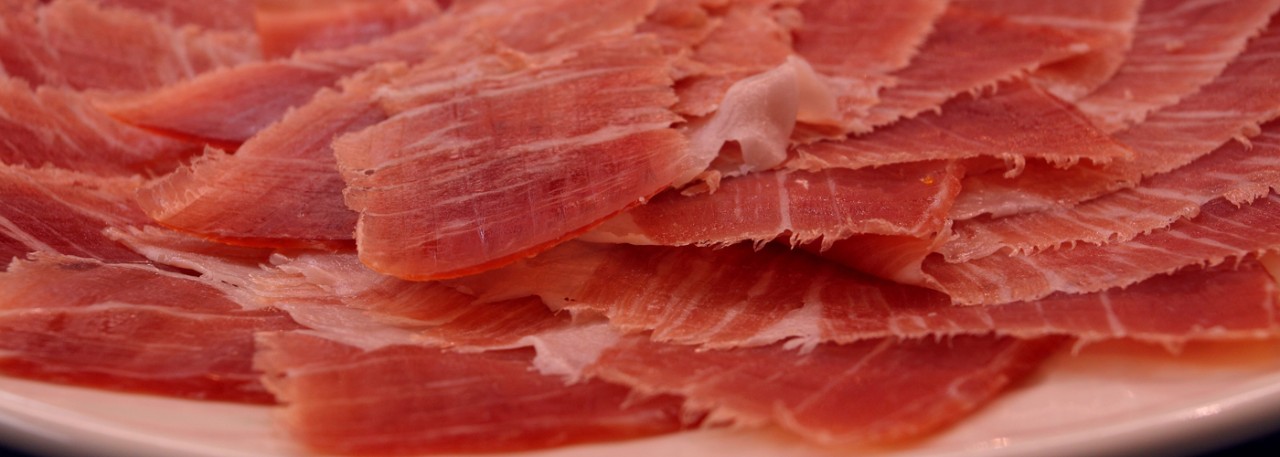.png.transform/rendition-xs/image_image%20(1).png)
Jamón de Teruel PDO
Cured hams (hind extremities) from white pigs born and reared in the province of Teruel, (Aragón) from a sow from cross breeds of the Landrace (standard) or Landrace White breeds (or cross-breeds of these two) and a boar from the Duroc breed, which are fed on cereals from the area, and have been subject to a minimum production process of 14 months.
Tasting notes
With a delicate and lightly salted flavor, the hams have a smooth, pleasant and suggestive aroma.
Other notes
Long and with rounded edges, they can be presented with all their rind or trimmed, using the so-called V Serrano cut. The piece, which still has its hoof, weighs between eight and nine kilos (17.6 and 19.8 lbs), and must never be any lighter than seven kilos (15.4 lbs). When sliced it is red in color, with partial fat infiltration in the muscle tissue. The fat is unctuous, shiny, white-yellow in color and aromatic.
Production / Processing method
Before being transported to the slaughterhouse, the pigs must fast for a minimum of 12 hours.
The Regulatory Council has established that the following races of white pig are authorized for producing Teruel ham:
- Sow: Landrace (standard), Landrace White or cross-breeds thereof.
- Boar: Landrace (standard) or Duroc.
The boars must be castrated before entering the rearing period, and the sows should not be in oestrus when slaughtered. The animals used for reproduction should not be used to produce hams protected by the PDO.
At the moment of slaughter, the live weight of the pig is 115-130 kg (253 – 286 lbs). At this stage they are eight months old, during which they were fed on milk for a month and a half and on dry feed for six and a half months.
The pig is given no medical treatment or product during the 15 days before slaughter, and remains at rest for a minimum of 12 hours before the slaughter, in order to reduce the fatigue and stress of transport. Before slaughter the pig is stunned, through electro-shock.
The only acceptable cuts will be those from pigs with fat that is a minimum of 4 cm (1.6 in) and a maximum of 7 cm (2.8 in) thick, measured at the 4th rib.
The pieces are obtained by cutting the hind extremity of the pig, at its uppermost part (the pubic symphysis), and their weight must not be any lower than 11.5 kg (25.3 lbs).
The carcass is aired for four hours at a temperature not exceeding ten degrees centigrade (50 ºF), with relative humidity of 90% for the first hour and 85% for the remaining time.
Once the channel has been quartered and the pieces profiled, they are kept for 24-48 hours at a temperature of between -2 and +2 ºC (28.4 – 35.6 ºF), until the middle of the pieces reaches a temperature of +2 ºC (35.6 ºF). The transport of the hams from the slaughterhouse to the curing and maturing premises is carried out in refrigerated vehicles, and they enter the salting area with an internal temperature of between zero and two degrees centigrade (32 and 35.6 ºF).
Firstly, the salting is carried out, with the incorporation of salt into the muscular tissue, encouraging dehydration of the pig’s extremities and their perfect preservation. The duration of this stage varies, and depends on the weight of the ham (with a maximum of 14 days).
The hams are then washed in lukewarm water to remove any salt, which may have become adhered.
In the rest or post-salting period, the remaining salt is absorbed uniformly throughout all the pieces, removing the water in a slow, gradual manner. This process is carried out by hanging the hams in rooms with temperatures of between three and six degrees centigrade (37.4 – 42.8 ºF), with relative humidity of 80-90%. The amount of time the pieces remain in these rooms depends on their weight, and varies between 45 and 90 days.
Afterword, the hams are then immediately hung in natural drying sheds, where ventilation is controlled to ensure optimum conditions of relative humidity and temperature.
Finally, the hams are transferred to cellars for maturation, where they remain hanging in humidity and temperature conditions derived from the natural atmosphere of a cold, dry area. The minimum total duration of the production process is 14 months.
The PDO product is identified by a flame-branded seal with the word Teruel and the star from the province's coat of arms, as well as a numbered band with the Regulatory Council's logo.
Geography / Relief and climate
The province of Teruel is located on the eastern side of the Meseta plateau that occupies the centre of the country, and on the south-eastern part of the great Iberian Depression.
It extends from the northern foothills of Cucalón mountain to the west, and from the region of Maestrazgo, located to the northeast of the province, towards the north and the north-east, until it reaches the River Ebro.
Cucalón Mountains, along with Sant Just Sierra (altitude 1,513 m (4,963 ft)), belongs to the External or Aragonese Mountain Range, located to the northeast of the province. These mountain ranges head towards the southeast of the Internal or Castellana Mountain Range, located on the Iberian border of the Meseta and made up of the Calatayud-Montalbán depression and the Calamocha-Teruel depression.
The climate is continental, with a Mediterranean influence, and is characterized by long, cold winters with harsh frosts in the moor areas. This is a dry climate, with many clear days. Annual rainfall totals approximately 400 mm (15.7 in), with some 70 days of rain each year.
The average annual temperature is 12 ºC (53.6 ºF), with the absolute maximum temperature being 37 ºC (98.6 ºF), and the minimum -12 ºC (10.39 ºF). The difference in temperature between the summer and winter is 19 ºC (66.2 ºF), and the frost-free period lasts from May to October.
Almost 70% of the surface area of the province of Teruel belongs to the Ebro Basin, and its waters reach this river through its tributaries: Jiloca, Huerva, Aguasvivas, Martín, Guadalupe and Matarraña. The remaining surface area is distributed between three of the largest basins on the peninsula (an Atlantic – the Tajo – and two Mediterranean, Júcar-Gabriel and Turia-Guadalaviar), and the basins of two minor rivers which belong to the north-eastern Mediterranean face of the Meseta, those in the Monleón-Mijares system.
Regulatory Council
Consejo Regulador de la DOP Jamón de Teruel
Avda. Sagunto, 116 (Edificio CEEI-Aragón)
44002 Teruel
Tel: (+34) 978 618 940
rtorres@jamondeteruel.com
www.jamondeteruel.com
Sources:
When sliced it is red in color, with partial fat infiltration in the muscle tissue.


- /content/dam/en/icex-foodswines/images/products/serrano-cured-hams-charcuterie/jamón-de-teruel-pdo/Jamón%20de%20Teruel%20PDO%20carr1.jpg
- /content/dam/en/icex-foodswines/images/products/serrano-cured-hams-charcuterie/jamón-de-teruel-pdo/Jamón%20de%20Teruel%20PDO%20carr2.jpg

Teruel (Aragón)
